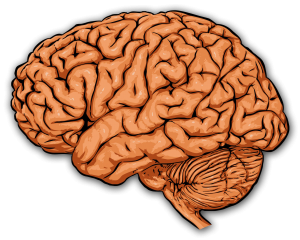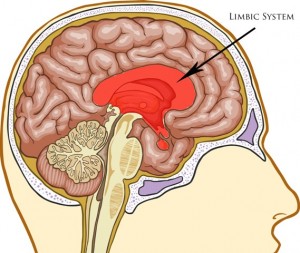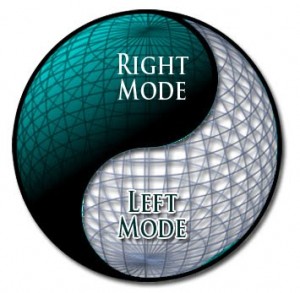The Neuroscience of Shadow Integration – Part II
Last week we defined the shadow, according to Carl Jung, and discussed how to recognize the shadow when it’s trying to get our attention. (See The Neuroscience of Shadow Integration Part I.) Today I’d like to talk about the possible neural correlates of the persona and the shadow. First, I’d like to point out that none of this is written in stone— a lot of it is theoretical. Most of the theories I’ll discuss, however, are a conglomeration of respected theorists, scientists, and thinkers. And I’ve been inspired to add in my own little twist on some of them. I think it’s important to collect this information and synthesize it in a teachable whole that inspires people.
Modes of Perception
Let’s start by exploring right and left modes of perception. This brings up images of the right and left hemispheres of the brain, and when I’ve talked about these modes with people educated in neuroscience before, they have sometimes interrupted, saying something like, “Hey, that’s lateralization. We all know that in any mode of perception, both the left and the right hemispheres are involved, and there’s no such thing as a perception solely correlated with just the right hemisphere or just the left hemisphere.” I agree, actually.
At the same time, however, Dr. Dan Siegel puts forth the idea of modes of perception—right modes of perception and left modes of perception—to describe how in certain perceptual processes there will be one hemisphere in which key things are happening that distinguish that particular perceptual mode as a right mode or a left mode of perception. Passive meditation would be a good example of this. We know that when we start to meditate passively, there is a diffused expanse of attention rather than a focused attention, and there’s a sense of allowing oneself to be meditated rather than trying to meditate.
What is happening neurologically in this case is the attention-association area in the right frontal lobe becomes active, while the areas around it, including parts of the left frontal lobe, tend to deactivate, when looked at under positron emission tomography. So, initially a process is ignited in the right hemisphere, and then when the activity stabilizes, it spills over to the left hemisphere. When this happens, deeper states of meditation emerge as a correlate of that activity. I’m not suggesting that the activity causes meditative consciousness, but the activity does co-arise with meditative consciousness. Because this particular process happens first in the right hemisphere, before it can take place in the left hemisphere, we can therefore call this type of meditation a right mode of perception.
Neural Correlates of the Shadow and Persona
Persona
 Building on this, let’s talk about the possible neural correlates of the persona and shadow projection. Last week, we described the persona as an excessive, narrow identification with the social mask—identifying with our biases, our belief systems, and our linear ideas about how reality should be. We often experience a distinct emotional charge when people challenge these ideas. We can say that there is a left mode perception happening here with the persona, because key areas in the left hemisphere are involved in linear, logical and literal thinking.
Building on this, let’s talk about the possible neural correlates of the persona and shadow projection. Last week, we described the persona as an excessive, narrow identification with the social mask—identifying with our biases, our belief systems, and our linear ideas about how reality should be. We often experience a distinct emotional charge when people challenge these ideas. We can say that there is a left mode perception happening here with the persona, because key areas in the left hemisphere are involved in linear, logical and literal thinking.
In fact, there was a recent study on transcranial magnetic stimulation, in which scientists used magnetic stimulation to deactivate the left anterior temporal lobe. This area has been correlated with the tendency to be locked into habitual, and generally very linear, ways of seeing the world. At the same time, they used the magnetic stimulation to activate the right anterior temporal lobe. What occurred was a holistic “opening up,” where people were able to re-contextualize their situation so that they could solve problems almost instantly, because of moving outside of their habitual way of seeing the world. In a genius-like way, they moved out of their linear, narrow world view and saw things in a big picture view. This clearly supports the notion that left hemispheric processes are involved in the persona.
Neuro-anatomist Jill Taylor, who suffered a stroke in her left temporal lobe, likewise associates narrow egoic identification with left mode perception:
“During the process of recovery, I found that the portion of my character that was stubborn, arrogant, sarcastic, and/or jealous resided within the ego center of that wounded left brain. This portion of my ego mind held the capacity for me to be a sore loser, hold a grudge, tell lies, and even seek revenge. Reawakening these personality traits was very disturbing to the newly found innocence of my right mind.” (from My Stroke of Insight, pg 145).
Shadow
Shadow projection is the idea that when there are parts of ourselves we don’t want to face, they are unconsciously projected out onto the world. According to Carl Jung, this is always accompanied by an emotional charge. That emotional charge has to be involved with the limbic system, since we know of its deep involvement in emotional experience. The limbic system, by the way, lies deep in the center of the brain, and governs our feelings and motivation. So, in the case of the persona and shadow projection, there seems to be a predominance of left-mode perception undergirded by unconscious limbic activity.
 Dr. Mark Waller has written about thecrucial roles the right brain and the limbic system play in our early formative development. A series of early studies showed that in the first two years of life in the human brain, the right hemisphere tends to be the most active of the two hemispheres of the neocortex. The limbic system is almost fully wired by the time we’re six years old, long before the prefrontal and the frontal areas, which are responsible for our higher order cognitive processes, come fully online.During our first six years, therefore, both our met and unmet emotional needs, and their corresponding positive and negative experiences, strongly impact the formation of the right brain and the limbic system.
Dr. Mark Waller has written about thecrucial roles the right brain and the limbic system play in our early formative development. A series of early studies showed that in the first two years of life in the human brain, the right hemisphere tends to be the most active of the two hemispheres of the neocortex. The limbic system is almost fully wired by the time we’re six years old, long before the prefrontal and the frontal areas, which are responsible for our higher order cognitive processes, come fully online.During our first six years, therefore, both our met and unmet emotional needs, and their corresponding positive and negative experiences, strongly impact the formation of the right brain and the limbic system.
Our emotional experiences, both positive and negative, literally become hardwired in the limbic system. These neural connections then emerge as a kind of attractor pattern. In chaos theory, attractor patterns are systemic patterns toward which systems, in this case the limbic system, tend to evolve. You can think of it as a specific pattern towards which the limbic system will be attracted. If you ever asked yourself, “Why do I continue to experience these same patterns over and over in my life?” this process plays a large role in that.
Mark Waller theorizes that these limbic attractors start to form sub-personalities. An unconscious process animates the limbic wiring and elicits the emergence of what he calls adialogical self, or our mosaic voice. We all grew up with a constant voice in our heads—sometimes positive, sometimes very negative. Mark Waller’s theory is that our sub-personalities are actually these different limbic attractors, formed during emotional experiences that weren’t fully and consciously processed. I would like to put forth that the shadow is, in part, a conglomeration of these limbic attractors/sub-personalities. Carl Jung very early on emphasized that the shadow is correlated with strong emotional charge, and strong emotion is always correlated with limbic activity.
Integrating the Shadow
 The important idea to grasp here is that as we grow more conscious, and as we become more conscious of the phenomenological emergence of the shadow, we can begin to be able to hold a witnessing consciousness that can witness this emotional energy coming up, without necessarily identifying with it. And not just witness it, but also feel down into it at a deep level; so not only is it a witness consciousness, but also a heart-centered mindfulness that plunges the depths of the emotional charge—in profound empathy—without being possessed or carried away by it. When we’re able to dive into the feeling level of this strong emotional charge and let go of our left mode stories—the voice that always says, “No, it’s that person’s fault; that person loves me the wrong way, etc.”—when we’re able to feel down into the heart of it while also witnessing it, key areas in our brains—the higher cognitive processing centers and the emotional centers—become more deeply integrated with one another. So, with shadow integration also comes neural integration.
The important idea to grasp here is that as we grow more conscious, and as we become more conscious of the phenomenological emergence of the shadow, we can begin to be able to hold a witnessing consciousness that can witness this emotional energy coming up, without necessarily identifying with it. And not just witness it, but also feel down into it at a deep level; so not only is it a witness consciousness, but also a heart-centered mindfulness that plunges the depths of the emotional charge—in profound empathy—without being possessed or carried away by it. When we’re able to dive into the feeling level of this strong emotional charge and let go of our left mode stories—the voice that always says, “No, it’s that person’s fault; that person loves me the wrong way, etc.”—when we’re able to feel down into the heart of it while also witnessing it, key areas in our brains—the higher cognitive processing centers and the emotional centers—become more deeply integrated with one another. So, with shadow integration also comes neural integration.
Possible Origins of the Shadow and Persona
The right hemisphere has to do with raw, spontaneous emotion, and according to the research of neuroscientist Richard Davidson, negative affect or negative emotion is correlated with excessive right hemispheric function. This makes sense if, in the first two years of our life, the right hemisphere is most active. The left hemisphere is not fully online yet, so we’re not able to consciously label the negative emotions that we’re feeling and integrate them into our consciousness. Instead, they just get stored, at least in part, in the limbic system via the right hemisphere, which already has quite extensive connections to the limbic system at this age.
That being said, it makes sense to me that the right hemisphere and the limbic system are the neural correlates of Jung’s personal unconscious. The personal unconscious is, in Jung’s definition, always associated with affect and imagery. We’ve already discussed the limbic system’s role in emotion, and scientific evidence strongly suggests that right hemispheric function and right modes of perception are deeply involved with human imagination. A prominent neuroscientist once stated that there are all kinds of unconscious processes happening all over the brain all the time, so it therefore seems unscientific to associate the unconscious mind with just right brain and limbic processes. And though I agree with that assertion, in this case I’m not talking about all unconscious processes, only Jung’spersonal unconscious, as he carefully defined it.
Next time, I’ll talk about why the neural correlates of the shadow are important and how brainwave entrainment, specifically the approach that the Profound Meditation Program takes, can work on the shadow, surface it, and integrate it.
___________________________________________________________________________
 Eric Thompson is a co-founder of iAwake Technologies, LLC and was its Chief Technology Officer. Although no longer with iAwake Technologies, his contributions have been immense. Eric is also an inventor, researcher, and producer, and is considered one of the world’s foremost brainwave entrainment experts. In addition, Eric is a pioneer in the development of biofield entrainment technology, which digitally captures and transmits life-enhancing and beneficial subtle energies to the human biofield via any digital medium, including pictures, audio, and film. By combining this emerging technology with an unconventional, innovative, and original approach to audio brainwave entrainment, Eric strives to make profound spiritual development and emotional freedom more easily accessible to all. He writes and speaks on the intersection between neuroscience, psychology, subtle energy, and spirituality.
Eric Thompson is a co-founder of iAwake Technologies, LLC and was its Chief Technology Officer. Although no longer with iAwake Technologies, his contributions have been immense. Eric is also an inventor, researcher, and producer, and is considered one of the world’s foremost brainwave entrainment experts. In addition, Eric is a pioneer in the development of biofield entrainment technology, which digitally captures and transmits life-enhancing and beneficial subtle energies to the human biofield via any digital medium, including pictures, audio, and film. By combining this emerging technology with an unconventional, innovative, and original approach to audio brainwave entrainment, Eric strives to make profound spiritual development and emotional freedom more easily accessible to all. He writes and speaks on the intersection between neuroscience, psychology, subtle energy, and spirituality.
___________________________________________________________________________
Leave a Comment
You must be logged in to post a comment.


Leave your comments below